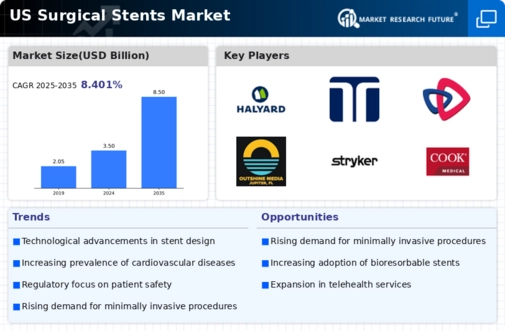Technological Innovations in Stent Design
Technological innovations in stent design are transforming the surgical stents market. The introduction of bioresorbable stents and advanced drug-eluting technologies has revolutionized treatment options for patients with arterial blockages. These innovations not only improve the efficacy of stenting procedures but also reduce the risk of complications, such as restenosis. The market for drug-eluting stents alone was valued at approximately $3.5 billion in 2023, indicating a strong preference for these advanced solutions among healthcare providers. Furthermore, ongoing research and development efforts are likely to yield even more sophisticated stent designs, enhancing patient outcomes and driving market growth. As healthcare professionals increasingly adopt these innovations, the surgical stents market is expected to expand significantly.
Increasing Prevalence of Cardiovascular Diseases
the rising incidence of cardiovascular diseases in the US is a primary driver of the surgical stents market.. According to the American Heart Association, cardiovascular diseases account for approximately 697,000 deaths annually, highlighting the urgent need for effective treatment options. Surgical stents are increasingly utilized to alleviate blockages in coronary arteries, thereby improving patient outcomes. The demand for stenting procedures is projected to grow as healthcare providers seek to address this pressing health crisis. Furthermore, advancements in stent technology, such as drug-eluting stents, enhance the effectiveness of these interventions, potentially leading to a higher adoption rate among healthcare professionals. This trend indicates a robust growth trajectory for the surgical stents market, as more patients require interventions to manage their cardiovascular health.
Aging Population and Increased Healthcare Expenditure
the demographic shift towards an aging population in the US significantly impacts the surgical stents market.. As individuals age, they are more susceptible to various health conditions, including those requiring stenting procedures. The US Census Bureau projects that by 2030, all baby boomers will be over 65 years old, leading to a higher prevalence of age-related diseases. Additionally, increased healthcare expenditure, driven by both public and private sectors, supports the adoption of advanced medical technologies, including surgical stents. In 2023, healthcare spending in the US reached approximately $4.3 trillion, with a substantial portion allocated to cardiovascular treatments. This financial commitment suggests a favorable environment for the surgical stents market, as healthcare providers invest in innovative solutions to meet the needs of an aging population.
Rising Awareness and Education on Cardiovascular Health
Growing awareness and education regarding cardiovascular health are pivotal in driving the surgical stents market. Public health campaigns and educational initiatives have significantly increased knowledge about the risks associated with cardiovascular diseases and the benefits of timely interventions. As patients become more informed, they are more likely to seek medical advice and treatment options, including stenting procedures. This trend is further supported by healthcare providers who emphasize preventive care and early intervention strategies. The American College of Cardiology reports that early detection and treatment can reduce the risk of severe complications, thereby increasing the demand for surgical stents. Consequently, this heightened awareness is likely to contribute positively to the growth of the surgical stents market.
Supportive Reimbursement Policies and Insurance Coverage
Supportive reimbursement policies and insurance coverage play a crucial role in the surgical stents market. The Centers for Medicare & Medicaid Services (CMS) and private insurers are increasingly recognizing the importance of stenting procedures in managing cardiovascular diseases. As a result, reimbursement rates for these interventions have improved, making them more accessible to patients. In 2023, approximately 80% of stenting procedures were covered by insurance, facilitating patient access to necessary treatments. This financial support encourages healthcare providers to offer stenting as a viable option for patients with arterial blockages. The favorable reimbursement landscape is likely to bolster the surgical stents market, as more patients can afford these life-saving interventions.

















Leave a Comment